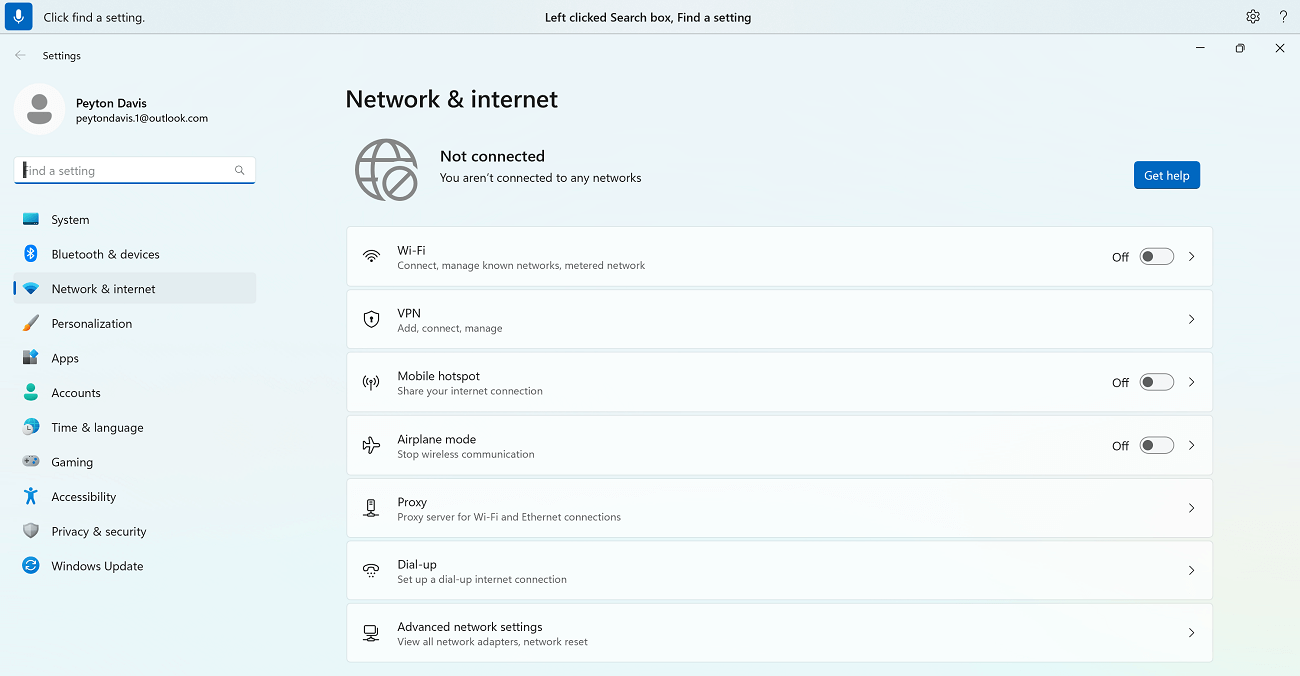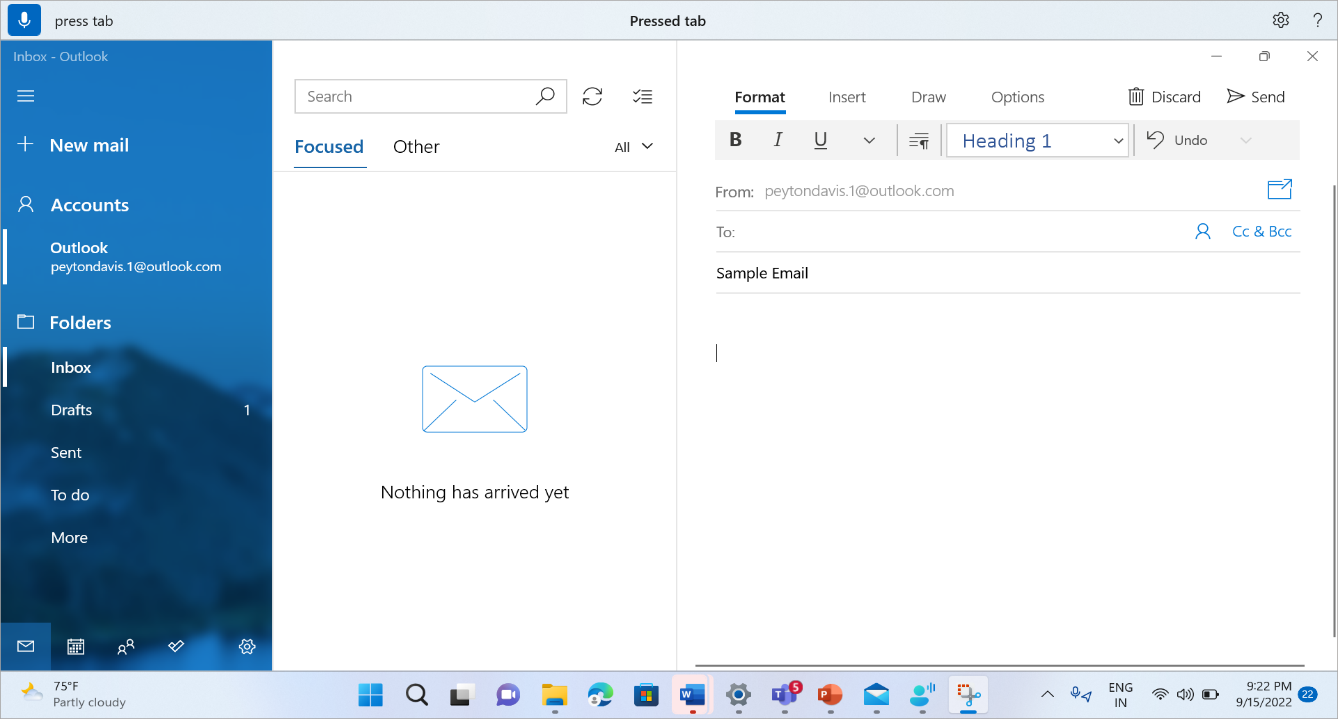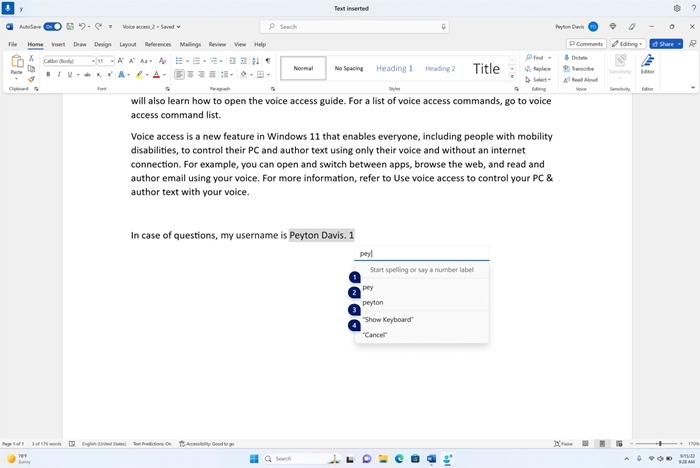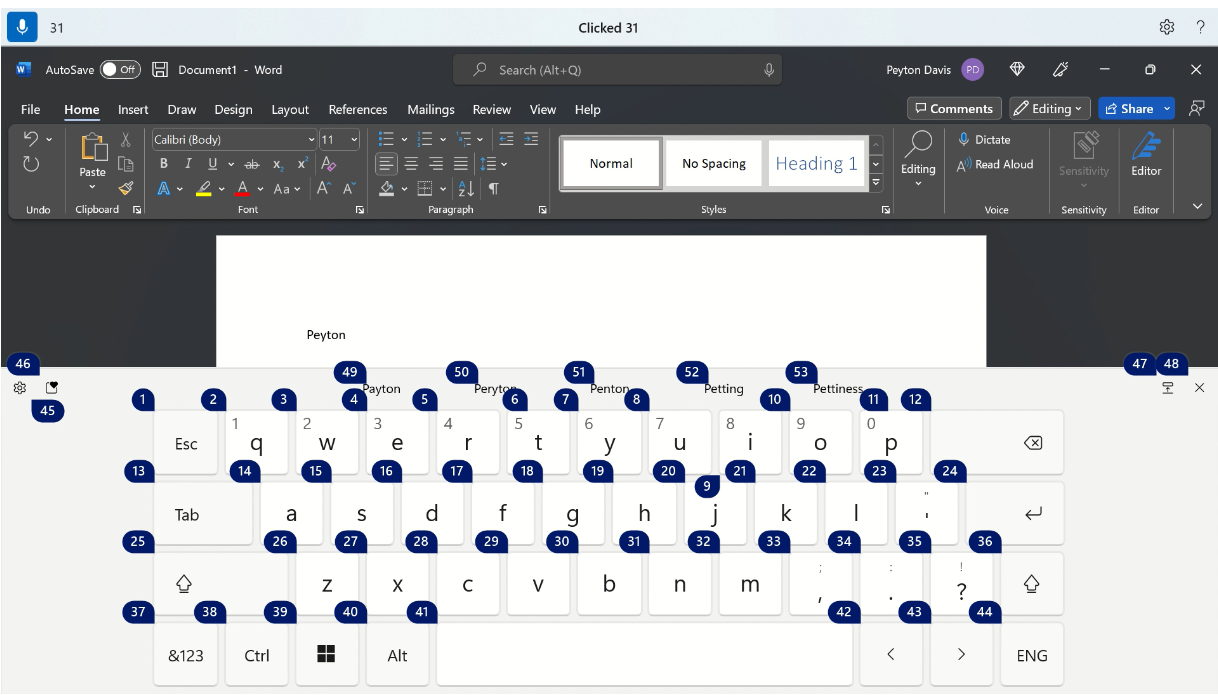This article is for people who want to control their PC and author text using their voice with Windows. This article is part of the Accessibility support for Windows content set where you can find more information on Windows accessibility features. For general help, visit Microsoft Support home.
Use voice access to dictate text and insert symbols and special characters using just voice commands. Voice access can also automatically punctuate your text and filter out profanities. For a list of voice access commands, go to Voice access command list.
Voice access is a feature in Windows 11 that enables everyone to control their PC and author text using only their voice and without an internet connection. For example, you can open and switch between apps, browse the web, and read and author email using your voice. For more information, go to Use voice access to control your PC & author text with your voice.
Voice access is available in Windows 11, version 22H2 and later. For more information on Windows 11 22H2 new features, and how to get the update, see What's new in recent Windows updates. Not sure which version of Windows you have? See: Find Windows version.
In this topic
Move the focus to a text box
To dictate text into a text box, first move the focus to the text box.
For example, if you want to search for a specific setting in the WindowsSettings.
|
To do this |
Say this |
Example |
|---|---|---|
|
To move the cursor to that specific location. |
"Click find a setting" |
"Display Settings" |
|
To get the mouse pointer to move to that specific location. |
"Focus on find a setting" |
"Display Settings" |
If you don't know the label of a text box, you can use number overlays to move the focus. Just say "Show numbers," followed by the number that is associated with the text box. Alternatively, you can move the mouse to get focus on a text box. For more information on how to work with the mouse or number overlays, go to Use the mouse with voiceor to the section "Interact with items using number overlays" in Use voice to interact with items on the screen.
You can move the focus between multiple text boxes and other buttons on a page by using the "Press Tab" or "Tab" commands.
For example, while composing an email, you can use the "Press Tab" or "Tab" commands to move the focus between the Subject and message body fields. You can also specify the number of times you want to press the Tab key. For example, you can say "Press Tab five times" to move the focus to the item five Tab key presses away. For more info on how to use voice to work with the keyboard, go to Use the keyboard with voice.
Dictate text
When you have moved the focus to a text box, you can start dictating text with your voice.
|
To do this |
Say this |
|---|---|
|
Insert text in a text box. |
"<The text you want to insert>" |
Tips:
-
Fluid dictation makes dictation with voice easier than ever—automatically correcting grammar, spelling, and punctuation as you speak. To learn more, refer to Fluid dictation.
-
Use the Add to vocabulary feature to add complex or difficult to pronounce words to improve dictation accuracy. This can be done from Voice access settings > Add to vocabulary or using the “add to vocabulary” voice command.
Note: If you want to insert special words in a text box, say "Type" or "Dictate," followed by the words you want to insert. For example, if you want to type the "What can I say" voice access command as text (and not perform the command), say "Type What can I say."
If you need to dictate capitalized words or capital letters, you can use the "Caps" command. For example, "Caps access" will insert "Access" at the text cursor.
If you want to add a piece of text without any white space before that text, you can use the "No space" command. For example, if you want to insert "helloworld" when "hello" has already been added to the text box, you can say "No space world" to get the desired text. You can make use of this command, for example, when entering usernames and email IDs.
|
To do this |
Say this |
Example |
|---|---|---|
|
Insert text at the cursor and capitalize the first letter of each word. |
"Caps <text>" |
"Caps hello world" |
|
Insert text at the cursor without any white space before the text. For example, if you have added the text "Peyton" to a text box and then want to insert "Davis," but you do not want to add a space before "Davis." The output will be "PeytonDavis." |
"No space <text>" |
"No space Davis" |
Note: You can also edit already dictated text using the "Capitalize that" and "No space that" commands. To learn more about these commands, go to Edit text with voice.
Spell non-standard words
If you need to enter non-standard dictionary words that are difficult to dictate such as people names, usernames, or email addresses, you can use spelling commands to dictate these words once and improve their recognition.
You can say "spell out" to bring up the spelling window. Alternatively, you can use "spell that" to select the last dictated text and bring up the spelling window. In this spelling window, you can dictate letters, numbers, symbols, the phonetic alphabet, and more. You will also get suggestions as you spell out the text. You can say "click 1" to enter the text you spelled out or say "click <number>" to pick a suggestion (if any). All words and phrases dictated using the spelling experience are added to Windows dictionary and will show up as suggestions when you try to spell them the next time.
For example:
-
To enter "Peyton" in the spell window, say the following in quick succession – "cap P", "e", "y", "t", "o", "n" followed by "click one" to enter in the application's text box.
By default, all letters are entered as lowercase letters. Use "cap" or "caps" prefix command to enter a capital letter.
For better recognition, say the letters in a quick succession.
To enter numbers, use the prefix "press". For example, say "press 2" to enter "2".
You can use NATO phonetic alphabet to improve recognition of the letters. For example, say "alpha" to enter "a", "bravo" to enter "b", "Charlie" to enter "c", etc. For more information, refer to NATO phonetic alphabets, code and signals.
You can use the text selection, deletion and navigation commands with "characters" unit in the spelling window. For example, "select last two characters". To learn more about the select command, refer to Select text with voice.
|
To do this |
Say this |
|---|---|
|
Spell out text letter by letter. |
"Spell out" |
|
Spell out selected text or last dictated text letter by letter. |
"Spell that" |
Tip: if you want to correct recognition mistakes done by voice access, you can use the "correct that" or "correct <text>" commands first and then use spelling commands if alternate text suggestions are not available for you to correct. To learn more about the correction commands, refer to Correct text with voice.
Use the touch keyboard
Similar to the spelling instructions detailed above, you can use the touch keyboard with your voice to enter non-standard words. Use this experience specifically in situations like entering passwords where you do not want the password text to be saved in windows dictionary.
For example, to type the name "Peyton," say "Show keyboard." Then say the number corresponding to the letter you need to type on the touch keyboard. You will also see suggestions come up and update each time you type a character. When you're done, say "Hide keyboard" to hide the touch keyboard.
|
To do this |
Say this |
|---|---|
|
Show the touch keyboard. |
"Show keyboard" |
|
Hide the keyboard. |
"Hide keyboard" |
You can also use the touch keyboard to insert an emoji. To bring up the emoji menu, say the number corresponding to the emoji button. In the example below, you can say "Click 46."
To insert an emoji from the emoji menu, say the number of the emoji you want.
Tip: To tab through different editable fields, press Backspace or Delete to fix any mistakes, or to press Enter to move to a new line, you can say "Tab," "Backspace," "Delete," or "Enter" without saying "Press" before the command. To learn more about using the touch keyboard with voice, go to Use the keyboard with voice.
Insert symbols and special characters
|
To insert this |
Say this |
|---|---|
|
. (Period) |
"Period" or "Full stop" |
|
, (Comma) |
"Comma" |
|
? (Question mark) |
"Question mark" |
|
! (Exclamation mark) |
"Exclamation mark" or "Exclamation point" |
|
's (Apostrophe followed by an s) |
"Apostrophe-s" |
|
: (Colon) |
"Colon" |
|
; (Semicolon) |
"Semicolon" |
|
" (Left double quotation mark) |
"Open quotes" |
|
" (Right double quotation mark) |
"Close quotes" |
|
- (Hyphen) |
"Hyphen" |
|
... (Three dots) |
"Ellipses" or "Dot, dot, dot" |
|
‘ (Left single quotation mark) |
"Begin single quote" or "Open single quote" |
|
' (Right single quotation mark) |
"End single quote" or "Close single quote" |
|
( (Left parenthesis) |
"Left parenthesis" or "Open parenthesis" |
|
) (Right parenthesis) |
"Right parenthesis" or "Close parenthesis" |
|
[ (Left square bracket) |
"Open bracket" |
|
] (Right square bracket) |
"Close bracket" |
|
{ (Left brace) |
"Left brace" or "Open brace" |
|
} (Right brace) |
"Right brace" or "Close brace" |
|
* (Asterisk) |
"Asterisk" |
|
\ (Backslash) |
"Backslash" |
|
/ (Forward slash) |
"Forward slash" |
|
| (Vertical bar) |
"Vertical bar sign" or "Pipe character" |
|
_ (Underscore) |
"Underscore" |
|
¶ (Paragraph or pilcrow sign) |
"Paragraph sign" or "Paragraph mark" |
|
§ (Section sign) |
"Section sign" |
|
& (Ampersand sign) |
"Ampersand" or "And sign" |
|
@ (At sign) |
"At sign" |
|
© (Copyright sign) |
"Copyright sign" |
|
® (Registered sign) |
"Registered sign" |
|
° (Degree sign) |
"Degree symbol" |
|
% (Percent sign) |
"Percent sign" |
|
# (Number sign) |
"Number sign" or "Pound sign" |
|
+ (Plus sign) |
"Plus sign" |
|
- (Minus sign) |
"Minus sign" |
|
x (Multiplication sign) |
"Multiplication sign" |
|
÷ (Division sign) |
"Division sign" |
|
= (Equal sign) |
"Equal sign" |
|
< (Less than sign) |
"Less than sign" |
|
> (Greater than sign) |
"Greater than sign" |
|
$ (Dollar sign) |
"Dollar sign" |
|
£ (Pound sterling sign) |
"Pound sterling sign" |
|
€ (Euro sign) |
"Euro sign" |
|
¥ (Yen sign) |
"Yen sign" |
Tip: You can dictate the symbol or the special character you want to insert along with rest of the text in a single utterance. For example, say "Hello comma how are you question mark" to insert "Hello, how are you?"
Turn on automatic punctuation
Voice access will automatically punctuate your text as you dictate it. By default, automatic punctuation is turned off. You can turn it on from the voice access bar.
-
To turn automatic punctuation on, on the voice access bar, select (Settings) > Manage options > Turn on automatic punctuation.
Use profanity filtering
If voice access captures a profane word, it is masked in the speech feedback. If a profanity is detected while you're dictating text, the masked version is typed out. By default, this option is turned on. You can turn the profanity filtering off or on from the voice access bar.
-
To turn profanity filtering on or off, on the voice access bar, select (Settings)> Manage options > Filter profanity.
See also
Use voice to interact with items on the screen
Technical support for customers with disabilities
Microsoft wants to provide the best possible experience for all our customers. If you have a disability or questions related to accessibility, please contact the Microsoft Disability Answer Desk for technical assistance. The Disability Answer Desk support team is trained in using many popular assistive technologies and can offer assistance in English, Spanish, French, and American Sign Language. Please go to the Microsoft Disability Answer Desk site to find out the contact details for your region.
If you are a government, commercial, or enterprise user, please contact the enterprise Disability Answer Desk.

















